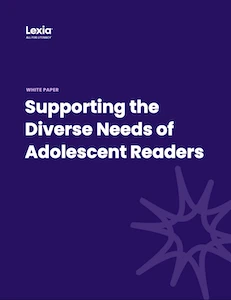Supporting the Diverse Needs of Adolescent Readers
Proficiency in reading impacts all subjects across the secondary curriculum. Adolescents differ in their reading proficiency and, therefore, differ in their levels of academic success. Some students demonstrate deep knowledge and vocabulary in class discussions but read slowly and inaccurately. Other students are fluent readers who nevertheless do not understand what they read. Without knowing and addressing the why, educators cannot improve the proficiency of adolescent readers. This Education Insight discusses the diverse and complex causes of non-proficient adolescent literacy, how to identify these gaps, and possible solutions for helping non-proficient adolescent readers not only read well but find reward in reading.
Reading proficiency in adolescence shapes not only academic success but also graduation trajectories and long-term opportunity. Yet too often, secondary students who appear engaged—contributing in class discussions or reading fluently—fall short on high-stakes assessments and struggle with grade-level texts. These gaps in proficiency persist across districts, and without a clear understanding of why they occur, well-intended interventions miss the mark.
This Education Insight explores the deeper causes of adolescent reading challenges, moving beyond surface-level data to reveal how decoding, linguistic comprehension, and other critical factors interact. Drawing from the Simple View of Reading and supported by research-based learner profiles, this paper equips district leaders with a framework to recognize and respond to the instructional needs often hidden in plain sight.
District administrators will find actionable guidance for strengthening diagnostic practices, designing targeted professional learning, and aligning curriculum and intervention supports across middle and high school systems. Whether addressing dyslexia-related decoding needs, supporting multilingual learners, or tackling engagement and mobility-related barriers, this resource connects classroom-level insight to district-level levers.
Reading success in grades 6–12 doesn’t just happen—it’s built. Start by understanding the why.
By submitting this form, I agree to receive information and marketing relating to news, updates on Lexia products and services, offers, and invitations to events from Lexia, and I understand and agree that Lexia may process and transfer my information to its affiliates globally and to third-party entities that provide services to Lexia for such purposes, in accordance with Lexia's Privacy Policy. I understand that I may opt-out of such communications at any time by clicking the link provided in the communication or by contacting Lexia at
privacy@lexialearning.com
This site is protected by reCAPTCHA and the Google Privacy Policy and Terms of Service apply.

